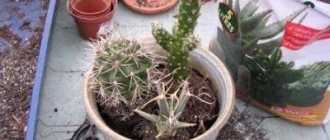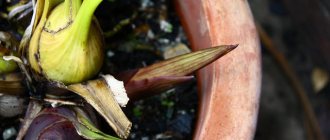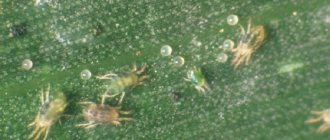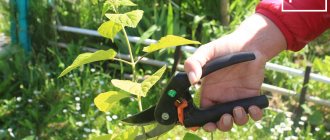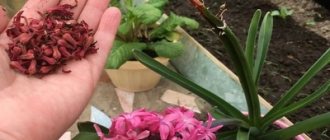Features of cacti as plants
These representatives of the flora belong to succulent plants. That is, they are able to accumulate moisture in their powerful stem. Unlike other green organisms, they do not have leaves. The shoots are covered with hard or soft spines involved in photosynthesis.
The Cactus family is numerous, with over 2 thousand species, which are combined into 300 genera. America is considered the birthplace and main place of growth. Mexico, Chile, Argentina, Sri Lanka are rich in various species. They grow in arid desert areas and tropical jungles. Succulents survive in extreme conditions.
The trunk, also called the body, can grow to enormous sizes in the wild. The height of the stems sometimes reaches 10 m. The highest height recorded by scientists was 19 m.
The shoots grow very slowly, the annual growth is usually small. Along with giant succulents, there are also miniature specimens. The diameter of the Blossfeldia cactus reaches 1 cm.
Thorns are needed not only for protection from predatory animals, but also for protection from the sun. No matter how thick the spines are, they cast a shadow on the trunk. The thicker the layer the shoots are covered, the higher the preparedness for the scorching sun.
The skin is dense, practically impermeable to gases and liquids. Pubescence often plays the role of an absorbent sponge.
Another interesting feature of most species is that the thorny bushes do not form inflorescences; the flowers do not have a peduncle. The flower acts as a continuation of the stem. With excess feeding, some growing buds change into babies.
Flowering for these representatives of the flora is an unstable phenomenon. Some specimens bloom annually, others very rarely and only under very favorable conditions.
Some varieties are covered with flowers all over the top, creating a cap. The duration of flowering also varies. While some specimens have flowers that last for several weeks, others may close after a few hours.
Depending on the species, plants take on different shapes. The trunks are wrinkled, with ribs and tubercles. The ribs can be pronounced or barely noticeable, smooth or spiral-shaped. Plants are covered with different spines: dense, sparse, long, short, soft or hard.
A person needs to be careful with thorns. The needles can prick, and in some species they are a source of poison.
Varieties and their distinctive features
Compact varieties bred through selective breeding are grown indoors. Today the choice of dwarf specimens is huge. Those cacti that grow in natural conditions differ from domestic inhabitants.
Desert cacti
Desert succulents are particularly resistant to heat and drought. The trunk and spines are adapted to the shortage of important components. With a lack of moisture, the ribs of the shoots become almost invisible, and after rains they acquire distinct outlines.
The root system of desert species adapts to external conditions. Depending on the circumstances, the roots accumulate moisture, contract or go deeper into the soil. Small roots can grow above the surface, collecting dew.
Unique adaptive properties have allowed succulents to survive for many centuries.
The most common desert cacti include Astrophytums, Mammillarias, Ariocarpus, Loffophora, Cephalocereus.
Forest cacti
Forest species differ from desert inhabitants and are more demanding of living conditions. Plants need high humidity and diffused light.
Forest succulents prefer to be located in trees, feeding on decomposition. They are also placed in rock crevices, catching on stones. Thanks to aerial roots they obtain moisture for themselves.
Externally, forest species differ from the usual representatives of the family. The shoots of the plants are elongated, hanging down, and the spines are more like bristles or hairs. Rhipsalis, Aporocactus, and Epiphyllum have become widespread.
Home cacti
Domestic species are represented by flowering and non-flowering species. Flowering is always spectacular and colorful. Among the adapted varieties there are specimens of a wide variety of forms. Non-flowering species are also attractive and have decorative properties.
Rebutia, Cereus, Notocactus, Echinocactus, Cephalocereus and many others have gained popularity as indoor plants.
Conclusion
Until recently, people sincerely believed that the cacti on the window were designed to absorb radiation from computer monitors, and nothing more. But although the prejudice has long been dispelled, man’s sympathy for these thorns remains. Representatives of succulents not only absorb dust and cleanse the atmosphere of rooms, they are quite capable of relieving you of stress and giving you a feeling of aesthetic pleasure. However, as has been said more than once in the article, getting a culture to bloom is very difficult and requires effort, but it is worth it. Therefore, unusual and lush buds are often a reason to get together with friends or relatives. The spiky beauty is actively used as an elegant decor and perfectly complements the style of the room. The above review contains only the most interesting representatives of the species, but which one you like and where to buy it, of course, is up to you.
Methods for growing cacti at home
Cacti can be propagated at home in different ways. Each has its own characteristics and advantages.
Seating of children (shoots)
The small, spiny shoots on the plant are called pups. These parts take root and grow well. Reproduction by this method is considered one of the simplest and most effective. It is believed that the strongest shoots are at the top of the cactus, while weaker specimens grow near the ground.
Even an inexperienced amateur can handle planting shoots. However, this method also has a drawback. Flower growers have noticed that each next generation raised from children becomes weaker. Plants are degenerating.
Cuttings
Most indoor plants reproduce in this way. The method is quite simple and effective. However, getting the segment is not so easy. There is a technology for cutting the cuttings and processing them. The cut fragment is left to lie for several days. This is followed by a long rooting phase. The cutting takes root no earlier than after 30-60 days.
Graft
Vaccination is needed in certain situations:
- root rotting
- long absence of flowering
- inability to reproduce in any other way
The method is complex and does not always give the desired result. After all, every living organism tries to get rid of a foreign fragment. The best time for the procedure is early summer.
For the event to be successful, the plant being vaccinated must be young and completely healthy, and also have a developed root system.
During the fusion period, it needs special conditions - warmth and humidity.
Planting seeds
When it comes to seed germination, cactus is called one of the most capricious plants. Growing a full-fledged prickly plant from a seed is quite a task. However, some gardeners still prefer this method.
Unlike other plants, cactus seeds cannot simply be buried in the ground - otherwise they will not germinate. In small greenhouses, beds are organized, at the bottom of which drainage is placed, previously scalded with boiling water.
Calcined sand is poured on top. Seeds will germinate only in conditions of high temperature (about 30 C) and humidity. The container is covered with glass or film and placed on the southern windowsill. The emerging sprouts will have to be handled very carefully.
Not all breeding methods are simple and quick. Fans of thorny plants most often resort to two methods: planting babies and cuttings.
How to properly plant a cactus with children
Seating children is the most acceptable method for a beginner. Suitable for those types of cacti that form these shoots. In some species they fall off on their own and take root after a while.
Children without roots are first placed in the substrate. Specimens with developed roots are planted directly in the ground.
Before planting a new young specimen in a pot, the children are rooted. The cut fragment is first slightly dried on a clean sheet of paper. To do this, be sure to choose a dark place.
The wider the cut area, the longer the process takes to dry. It takes at least 1-2 days for a dry callus to appear. If the children fall off on their own, rooting begins immediately. There are two ways to do this.
Placement in substrate
For rooting, take a small pot, which is only a couple of centimeters larger than the diameter of the shoot itself. During the process, it is very important that the water does not stagnate, otherwise the cut will rot. Therefore, the container must have drainage holes.
A slightly moist sandy mixture is used as soil (2 parts sand to 1 part soil). The spiny shoot is carefully applied with a cut to the surface. Please note that the section is not buried or covered with soil.
Watering is carried out especially carefully. A plant without roots easily moves and falls to the side. Perform the movements as carefully as possible, and do not move the pot until the roots appear. For stability, the baby is covered with small pebbles or vermiculite. Roots form after 7-12 days.
Rooting in a glass
Rooting directly in water is completely unsuitable. The cut rots long before roots form. There is an unusual rooting technology.
The shoot is attached to the glass so that the cut is at a distance of 5-6 cm above the water level. As water evaporates, carefully add water, bypassing the plant itself. The liquid temperature is maintained at 27-30 C.
The children are planted in pots after roots have formed. While the plants are small, one container is suitable for several specimens.
What to do if it doesn’t take root?
The plant does not take root due to improper human actions during reproduction
- If we talk about lighting, then you should choose the south side.
- The flower does not like to be frequently moved from place to place. For a cactus it should be constant.
- Watering should be moderate, water at room temperature. Many species generally do without water for a long time.
- The soil should be light. Ideal combination: one part each of sand, leaf soil and ordinary soil.
Basic land requirements for planting a cactus:
- Porosity, the soil should allow air and water to pass freely.
- The soil should be somewhat rough and lumpy.
- Should not contain undecomposed organic substances.
Reproduction of cacti is not too difficult, although it does require some special knowledge. Sometimes one method of propagation and rooting may not be suitable for a certain type of cactus, so there are several options for propagating the plant.
If you find an error, please select a piece of text and press Ctrl+Enter.
How to remove babies from a cactus and whether they need to be torn off
In order for the mother plant to remain healthy and the children to take root successfully, they should be removed correctly. Most people prefer to do this with tweezers. Under no circumstances try to remove the shoots with your hands.
It should be separated so that there are no pieces of the shoot left on the main trunk, and no pieces of the mother’s body left on the baby. Otherwise, rotting of the bush or separated fragment may occur.
To minimize the risk, gardeners recommend cutting off shoots with a sharp, disinfected knife.
If you are taking children for seating, use the following tips:
Wait until the growth reaches a size of 1.5-2 cm. A specimen that is too small will not be able to provide nutrition on its own and will dry out without ever taking root.
The most suitable time for reproduction is spring and early summer.
You can wait until the growth falls off on its own. You shouldn't wait longer than August. In autumn, the plant takes root worse.
Flowering is not a good time to reproduce.
Is it necessary to specifically cut off children? If you are not doing this for the purpose of reproduction, be guided by your taste. Sometimes a bald spot forms at the site of removal, which spoils the appearance. If the shoots grow throughout the trunk, the plant takes on an unusual appearance.
The need to cut off shoots appears when the plant becomes sick and begins to look bad. The bush will need strength and nutrition to recover.
DIY pots
It is not necessary to purchase expensive pots in specialized stores. If you use a little imagination, you can easily make it yourself.
There are special kits in which you can make a pot of your choice from polymer clay or gypsum. You can also use improvised means - use an old unnecessary cup and even cupcake molds, which you can further decorate with rope, glue and decorative devices. A coconut shell will serve as a perfect container for planting a small cactus. Don't forget to drill holes for drainage. For those who appreciate individuality and interior decoration, with some effort and patience, you can make a wooden house for cacti.
House for cacti
It is believed that cacti are grown most often by people with restrained emotions and strict character. After all, this is what this flower, covered with thorns, looks like at first glance. But thanks to their beautiful and rare flowering, cacti are popular with many amateur gardeners who are able to appreciate the beauty and elegance of this plant and grow a wonderful specimen. Thanks to its unpretentiousness and ease of care, even the most inexperienced and busy person can wait for flowers.
How to plant a cactus shoot with roots
The shoots with roots are planted in a pot with soil. The landing technology is as follows.
When choosing a container for planting, pay attention to the material. Plastic containers cool less and retain moisture longer. A light color attracts the sun less and protects against overheating.
It is advisable to have drainage holes at the bottom. If there are none, do them yourself, or increase the thickness of the drainage layer. Containers with a small diameter stimulate the growth of the root system.
It is necessary to lay a drainage layer at the bottom, occupying a quarter of the container. Crushed brick or expanded clay will do. This technique removes excess moisture and protects the roots from rotting.
It is best to purchase a ready-made substrate. Instead of a store-bought mixture, combine chernozem, crushed dry leaves and river sand. The bush likes loose soil, so don’t try too hard to compact the soil.
A depression is made in the center of the container, where a young cactus with roots is planted. You cannot bury the bush deeply and press it down.
Although in the wild they have a powerful root system, houseplants are endowed with small roots. Subsequently, the adult plant is transplanted into a pot of larger diameter as it grows.

